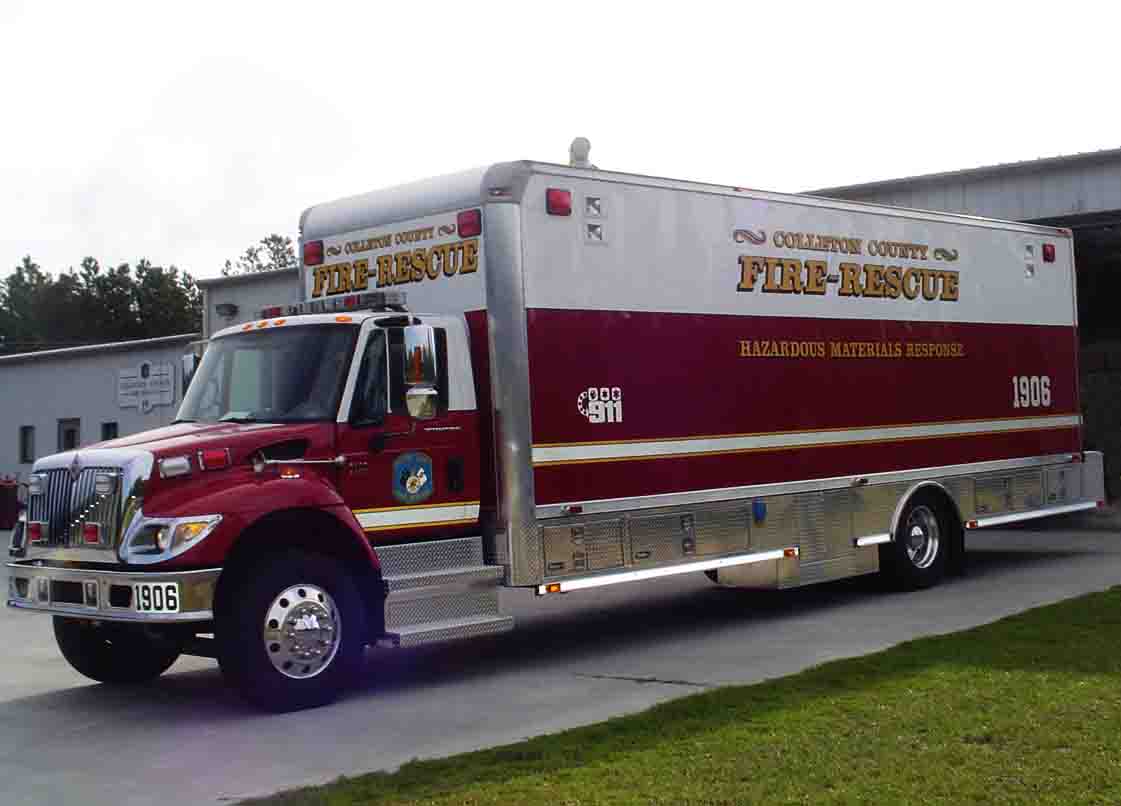

Colleton County Fire-Rescue
Apparatus Types
Engine (Pumper) -


Tender -
 |
The main water supply apparatus in rural firefighting,
these types of vehicles vary in size and design depending on the needs of the
community it serves. In Colleton
|
The primary purpose of the tender is to supply water to the Engine. This is accomplished in two ways. The tender can pump water to the Engine through large fire hoses directly from its fire pump or a Water Shuttle operation can be performed. For most residential house fires, the pumping method is used. For any sustained operations, where large quantities of water will be needed, the water shuttle method must be performed.
Water Shuttle Operation -
When large volumes of water
are needed, a Fire Department Officer may make the decision to set up a Water
Shuttle Operation. As the name implies, several tenders shuttle water to a fire
scene. It is an actual operation and requires several units and manpower
separate from the firefighting effort. In
The first Tender to arrive at
the fire scene leaves a 2500-gallon portable tank at the fire scene. It then
dumps its full load of water into the tank. Tender 1 then drives to the nearby,
pre-determined water point, such as a pond, to be refilled by another Engine who
has set to draft water from the pond. This water supply engine uses its large
suction hoses to draft water from the water source and then pumps the water
through smaller hoses (3 inch to 5 inch diameter) to a waiting Tender. The
Engine at the fire scene, drafts the water out of the portable tank for use it
in the firefighting effort. As the water level drops, the second tender arrives
and dumps its load of water, then drives to the nearby pond to be refilled. The
remaining responding tenders do the same. The system works by having one Tender
at the scene of the fire, one Tender refilling and two Tenders in transit,
working in a continuous cycle or “Shuttle”. The process requires at a
minimum seven firefighters to make it work. Two at the fill site to operate the
Engine drafting water at the pond/river, one driver in each Tender and at least
one water supply officer at the fire scene to manage the dumping process. The
water supply officer’s sole job is to manage the water shuttle operation so
the firefighting Engine never runs out of water. If the need arises, additional
tenders can be added to the water shuttle operation or an entirely separate
water shuttle operation can be run if a large amount of water is needed. This
would of course require an additional Engine for another pond/river and four
more tenders.


Rescue /
Service Truck / Squads -
 |
Specialized vehicles are used
to fill the capacity of Rescue Trucks or Service Trucks. In |
Heavy
Rescue -
|
Colleton County operates two
Heavy Rescue trucks. Rescue 1, the larger of the two trucks, responds out
of Station # 1 in the center of the county, while Rescue 18 responds from
Station # 18 on the west side of the county. The two apparatus have the
primary purpose of responding to incidents where a person may be trapped
or to support incident operations at other types of emergencies. This
would include vehicle accidents, machinery, trench or high angle rescues.
Both units carry basically the same compliment of equipment and a
multitude of specialized rescue gear. This includes Holmatro hydraulic
extrication tools, ropes, cribbing, hand tools, climbing gear, large
generators and a light tower for illuminating emergency scenes at night. Rescue 1 is equipped with a
mobile breathing air compressor. The compressor can operate for long
periods at emergency scenes to refill compressed air cylinders (SCBA) and
station cascade systems. Rescue 18 is equipped with a four cylinder
cascade system, which fills a similar purpose, but has a limited supply of
air. |
|
Hazardous
Materials -
|
|
Colleton County uses two vehicles to Hazardous Materials Responses. The primary HazMat Response vehicle is an E-One walk-in style Heavy Rescue designed for HazMat use. The spacious unit has a climate controlled Command Post, generous compartment space, external thermal and visual cameras, a mass spectrometer, multiple detection and identification devices, communications equipment, Level A, B and C protection garments, decontamination device, including a hot water heater. Additional equipment and supplies, Decon tents and heavy equipment are carried on the HazMat Tender, a Supreme Box Truck and several support trailers. | ||
 |
|
 |
|
Aerial
Platform / Quint -
|
|
 |
Ambulance
/ Medic Unit
 |
Colleton County utilizes
the Wheeled Coach Type 1 MAV (Medical Attack Vehicle), as its primary
Emergency Medical Response and transport vehicle. Each unit is mounted on a
dependable Kenworth T270 chassis and provides a generous amount of storage
space and patient comfort. Supplied with dual environmental comfort systems,
a heavy-duty electrical system, Paccar 350 horse power diesel engine and
high payload, the units have far out performed previous ambulance chassis
used by the County. |
Aircraft Rescue Fire Fighting (ARFF) Vehicle
|
Colleton County
utilizes an E-One Titan II Aircraft Rescue Fire Fighting (ARFF) truck
primarily to respond to emergencies in and around the Lowcountry
Regional Airport. This versatile firefighting vehicle, is self
sustained, carrying 1500 gallons of water and 190 gallons of foam
concentrate. Like most modern ARFF vehicles, it is equipped with
electronic controls to enable firefighters to combat aircraft fires
from the safety of the cab. Colleton County's ARFF is also equipped
with an exterior structural pump panel to allow the unit to be used for
other purposes. It is also equipped with two pre-connected
1-3/4" handlines, a booster reel and a variety of hand tools.
The vehicle is
not limited to only airport use. With it's ability to flow large volumes
of firefighting foam, the ARFF is extremely useful on all fuel fires,
incidents involving tanker trucks and with it's ability to go off road,
it can also be used on large wildland fires.
|
|
Water Rescue Vehicle
 |
Fire-Rescue
operates a 19' Carolina Skiff and two Inmar 430-SR-HD-S Inflatable Boats
with 25hp Jet Drive motors for search & rescue missions and
dive/recovery operations on the inland waterways. With the County being
surrounded on three sides by rivers and the Atlantic Ocean to the south,
the flat bottom Skiff serves the department well. With its low draft,
the boat is able to transverse shallow inlets, support dive operations
and is useful in searching for missing boaters and/or rafters. The
inflatable boats allow for accessing difficult areas and managing swift
currents. Fire-Rescue also operates a 21' Boston Whaler for
operations in larger water.
|
|
 |
 |
 |
First Response Units
|
Fire-Rescue
utilizes a variety of vehicles as medical first response units. With all
personnel being cross-trained as firefighters and EMTs (Paramedic,
Intermediate or Basic) all staff vehicles carry life saving emergency
medical equipment the same as the department's ambulances. These
multi-purpose vehicles serve as Command Posts, Emergency Medical First
Response Units and crew transport vehicles. Each is equipped with a
heavy duty winch for rescue/recovery operations, four wheel drive to
transverse adverse road conditions during time of emergencies/poor
weather and/or off road operations and towing ability for the
transport of the departments boat, mass casualty trailer, foam trailer or
fire & life safety education trailer.
The F-250 pickup
trucks are also wired for the quick installation of skid units (portable
150 to 250 gallon wild land firefighting units) that can be quickly
installed within minutes, to convert the pickup truck into a wildlands
firefighting unit.
|
|